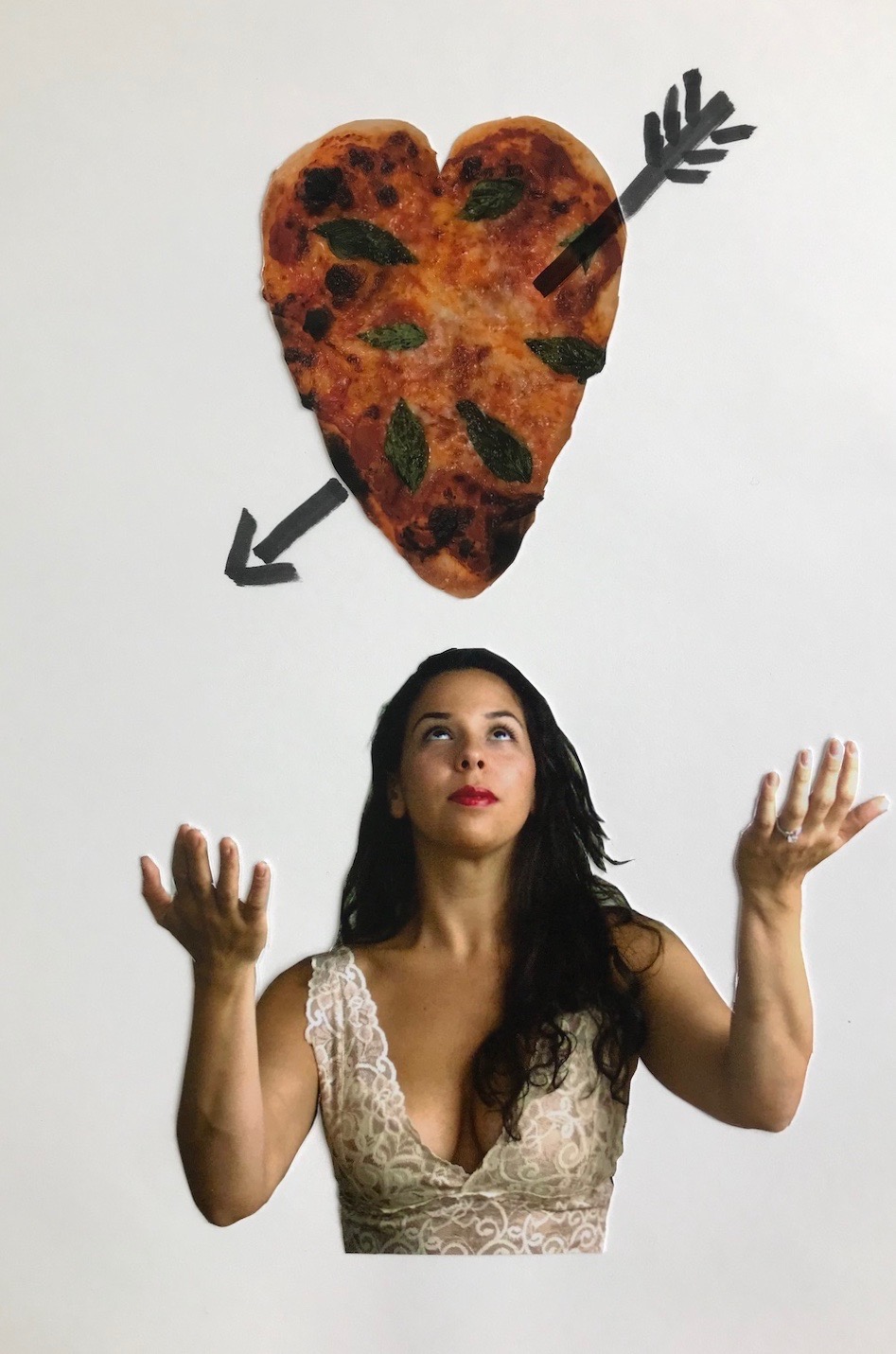MARIANI’S
Virtual
Gourmet
May 3, 2020
NEWSLETTER
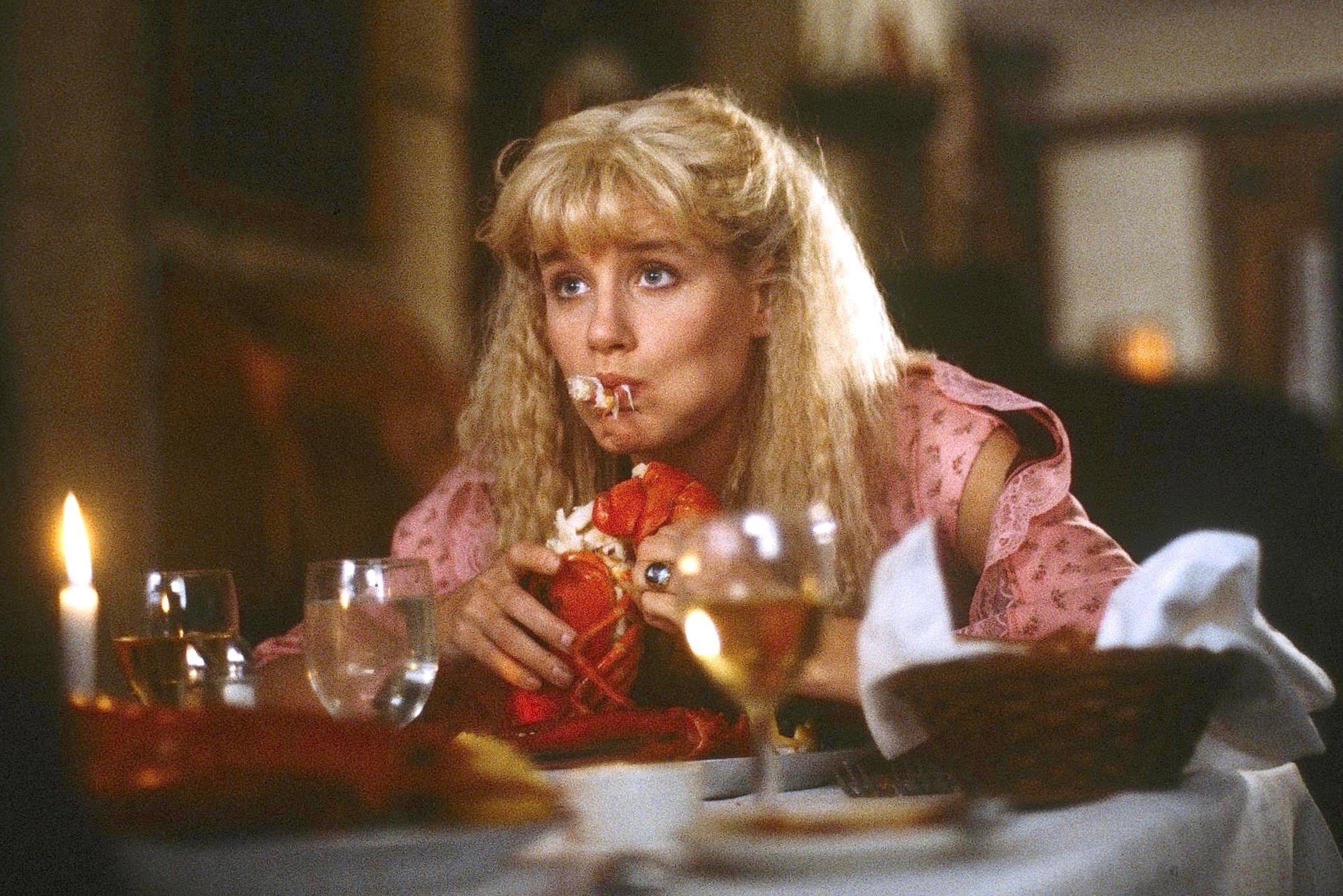
❖❖❖
IN THIS ISSUE
WHY THE RESTAURANT INDUSTRY WILL COME
BACK BETTER THAN EVER
By John Mariani
BEN BENSON, MASTER STEAKHOUSE OWNER,
PASSES AWAY AT 81
NEW YORK CORNER
LOVE AND PIZZA
Chapter Six
By John Mariani
NOTES FROM THE WINE CELLAR
COMFORT WINES
By Geoff Kalish
❖❖❖
WHY THE RESTAURANT INDUSTRY
WILL COME BACK BETTER THAN EVER
By John Mariani
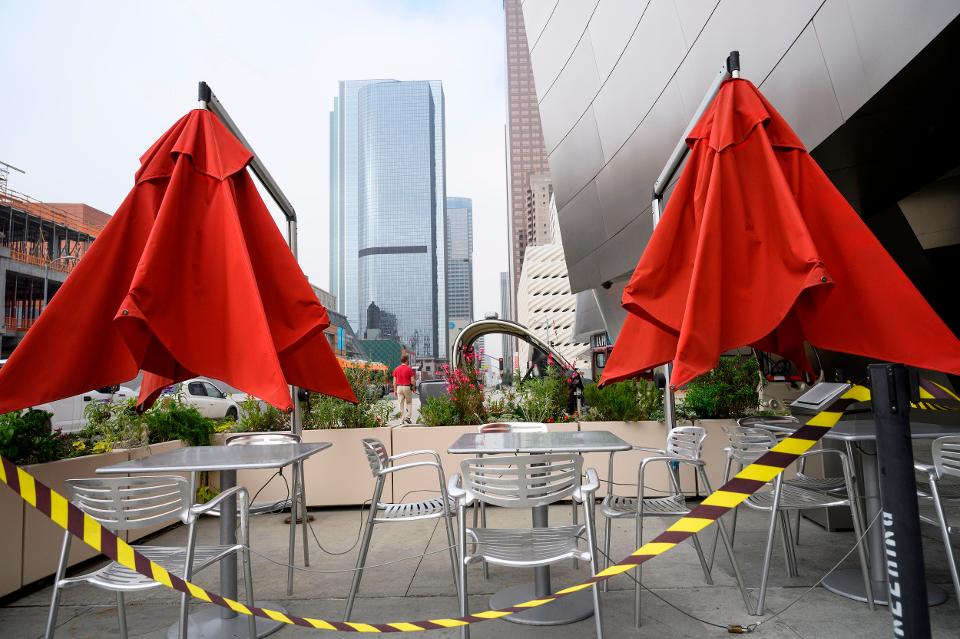
Food critics are not prone to
being Pollyannas, but in the face of so much
gloom and doom about the future of the world’s
restaurant industry during the current pandemic,
as a culinary historian I remain very
optimistic.
The California Restaurant
Association contends that as many as 30,000 of the
state’s 90,000 restaurants might close for good.
“I expect 70% of restaurants will close as a
result of this,” said Tom Colicchio, host of
Bravo’s Top
Chef. He may well be right, but there will
be another 70% to replace them. For more than most industries
providing a social need restaurants have a long
history of adapting to boom and bust times, not
least because of the kind of people who go into a
business that is very difficult even in
good times. To open and run a restaurant takes not
just a commitment of time and effort — as it would
be for, say, a dry cleaners, an auto body shop or
hair salon, whose owners are likely drawn to the
business for the chance to make a living for their
families.
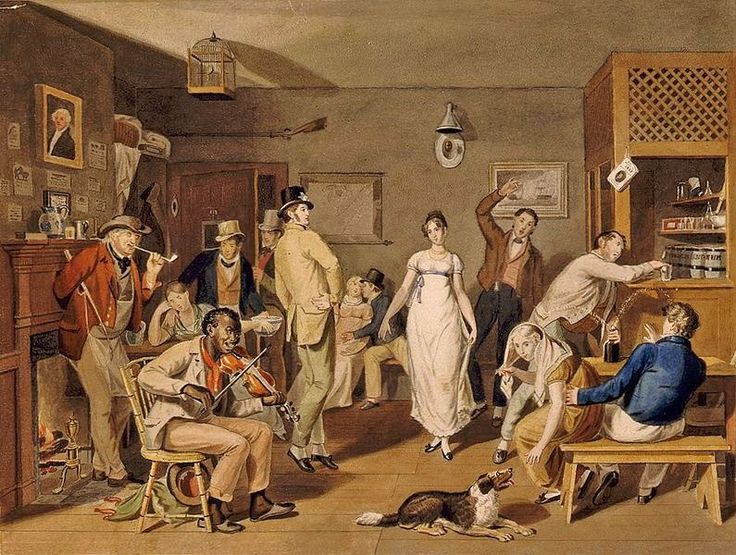 Opening a
restaurant demands a fervent love of
the business, from the owners to the chefs and
often the waiters and busboys who fantasize about
someday owning their own place. Even restaurateurs
who beg their sons and daughters not to follow
them in the rough-tough business find their
children often leave other, more secure
professions to come back to work in the family’s
restaurants.
And because of that love restaurants have
historically proven far more resilient than many
other small businesses, not least after wars and
pandemics have utterly destroyed them.
Opening a
restaurant demands a fervent love of
the business, from the owners to the chefs and
often the waiters and busboys who fantasize about
someday owning their own place. Even restaurateurs
who beg their sons and daughters not to follow
them in the rough-tough business find their
children often leave other, more secure
professions to come back to work in the family’s
restaurants.
And because of that love restaurants have
historically proven far more resilient than many
other small businesses, not least after wars and
pandemics have utterly destroyed them.
One
cannot go back to Ancient Rome, the Middle Ages or
even the 18th century to demonstrate restaurants’
survival abilities, simply because, before the
19th century, the only eating places open to the
public were just roadside taverns and cafés. Restaurants as we know
them—where you can sit at a table, choose from a
menu, order wine and get good service—are
really a phenomenon of the era following the
bloodiest days of French Revolution, when the
former cooks for the aristocracy opened bistros 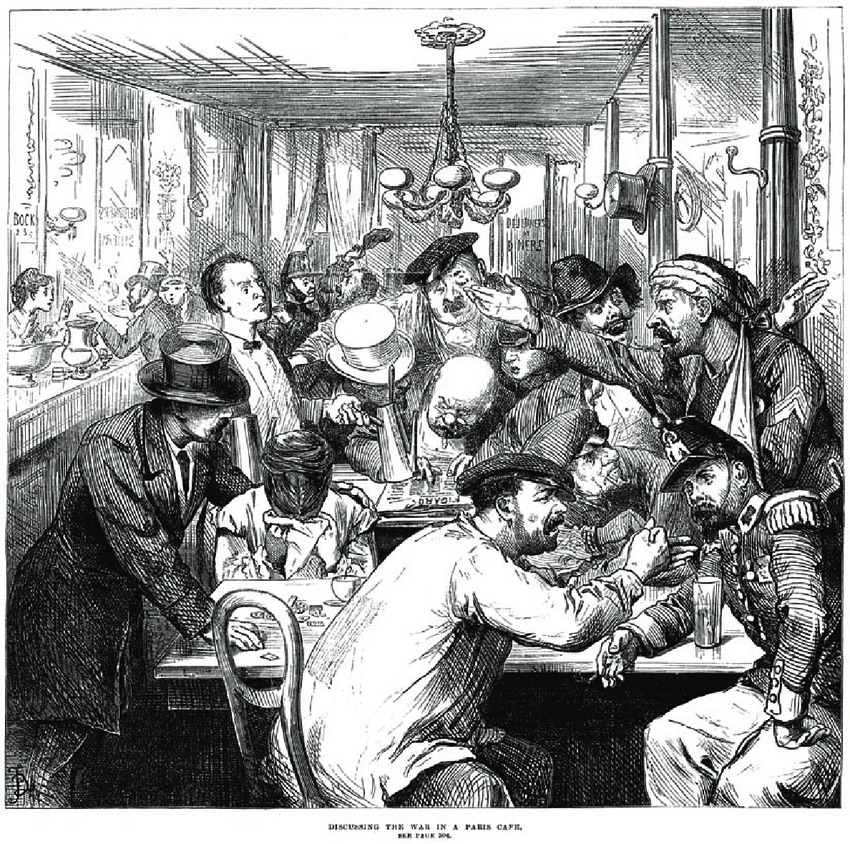 and
full-fledged restaurants to appeal to the
burgeoning bourgeoisie. (Some believe the word
“bistro” comes from the days when, after the
Napoleonic Wars, Russian troops streamed into
Paris shouting “bistra,
bistra!”—“quick, quick!”—to get a meal.)
and
full-fledged restaurants to appeal to the
burgeoning bourgeoisie. (Some believe the word
“bistro” comes from the days when, after the
Napoleonic Wars, Russian troops streamed into
Paris shouting “bistra,
bistra!”—“quick, quick!”—to get a meal.)
Even during the Prussian siege
of Paris in 1871 during the Franco-Prussian War,
with many people starving and butchers selling
cats and dog meat, the bistros and fine dining
restaurants stayed open. Running low on basic
ingredients, cooks began serving elephant steak
and stewed beaver from zoos. In
fact, one journalist wrote, “We will end up going
through the whole of Noah’s Ark.”
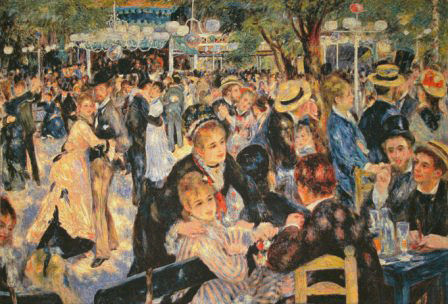 After
the war, the
Golden Age of Paris restaurants began with the
establishment of grand brasseries on Montparnasse,
which became the epicenter of artistic social
life, and the opening of the vast Les Halles
market, where every conceivable food from all over
Europe was brought in by rail and sold.
After
the war, the
Golden Age of Paris restaurants began with the
establishment of grand brasseries on Montparnasse,
which became the epicenter of artistic social
life, and the opening of the vast Les Halles
market, where every conceivable food from all over
Europe was brought in by rail and sold.
Through World War I Paris’s
restaurants stayed open and they
thrived through the Jazz Age. Not even the
so-called Spanish Flu of 1918-1919, which killed
upwards of 250,000 French people, nor the global
Depression of the 1930s, much affected them, as
chronicled by habitués like 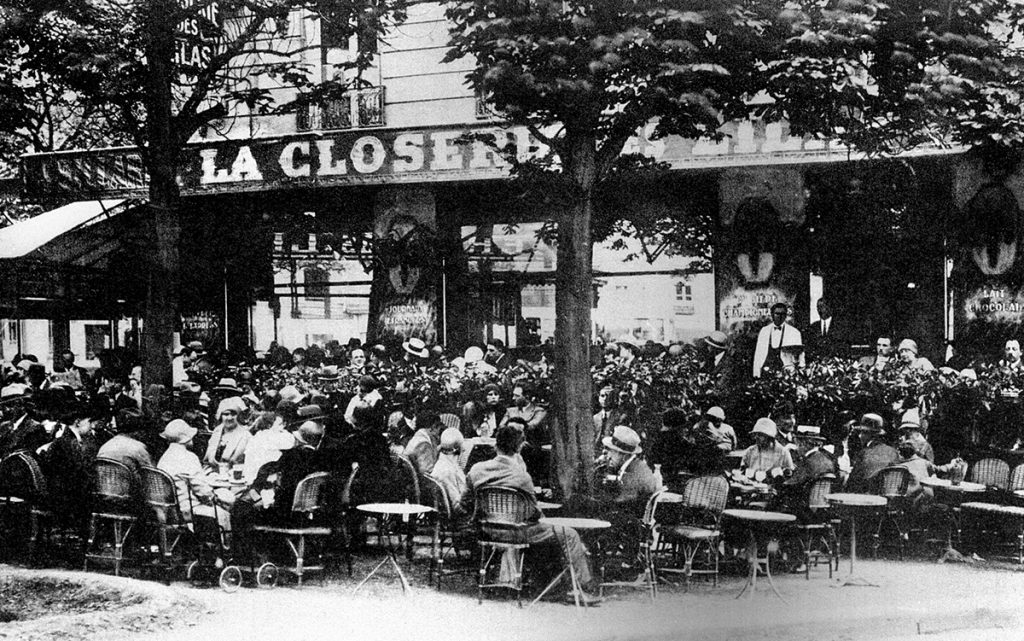 Ernest
Hemingway and F. Scott Fitzgerald, who made names
like La Rotonde, La Coupole and La Cloiserie des
Lilas (right)
famous. Even during the German occupation of the
city early in World War II, restaurants stayed
open, working off rationing, while the grandest
dining rooms, especially in the hotels, became the
exclusive haunts of German officers. (The scene in
the movie “Inglorious Basterds,” wherein a Nazi
officer dines sumptuously with a woman he is
interrogating is both chilling and sickening.)
Ernest
Hemingway and F. Scott Fitzgerald, who made names
like La Rotonde, La Coupole and La Cloiserie des
Lilas (right)
famous. Even during the German occupation of the
city early in World War II, restaurants stayed
open, working off rationing, while the grandest
dining rooms, especially in the hotels, became the
exclusive haunts of German officers. (The scene in
the movie “Inglorious Basterds,” wherein a Nazi
officer dines sumptuously with a woman he is
interrogating is both chilling and sickening.)
In other European countries
whose cities were bombed into rubble, as in Italy,
Belgium, England and, especially, Germany, the
first small businesses to open after the war were
eating places. By the mid-1950s Italy was enjoying
“Il Boom,” with restaurants central to a new
vitality in cities like Rome, Milan, Venice and
Naples. One has only to read of the gourmet meals
James “007” Bond enjoyed throughout Europe in Ian
Fleming’s novels of the 1950s to sense how quickly
the continent went from starvation to abundance.
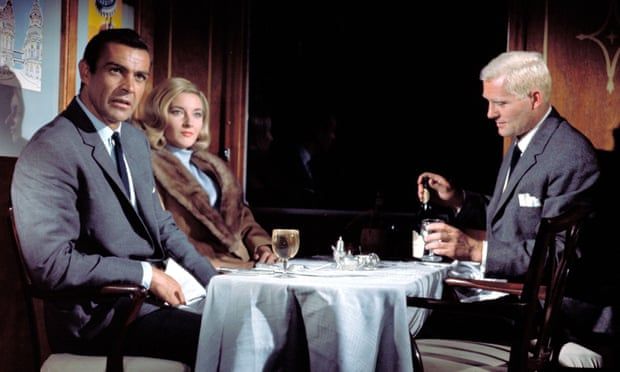 America
had
had a lively restaurant industry since the 1840s,
largely unaffected by wars, earthquakes and
recessions, and it was increased enormously by the
arrival of millions of immigrants in the late 19th
century who opened trattorias, chop suey shops,
chili parlors, diners, rathskellers and
delicatessens. The industry did live under
rationing during World War II, but the restaurants
of major cities like New York, Los Angeles and San
Francisco, with huge influxes of servicemen coming
and going, did very well. After the war, with the
permanent return of those servicemen and women,
America boomed, the Interstate Highway system was
built and the industry responded with the creation
of fast food eateries, chain restaurants, theme
restaurants and high-end ethnic restaurants
everywhere.
America
had
had a lively restaurant industry since the 1840s,
largely unaffected by wars, earthquakes and
recessions, and it was increased enormously by the
arrival of millions of immigrants in the late 19th
century who opened trattorias, chop suey shops,
chili parlors, diners, rathskellers and
delicatessens. The industry did live under
rationing during World War II, but the restaurants
of major cities like New York, Los Angeles and San
Francisco, with huge influxes of servicemen coming
and going, did very well. After the war, with the
permanent return of those servicemen and women,
America boomed, the Interstate Highway system was
built and the industry responded with the creation
of fast food eateries, chain restaurants, theme
restaurants and high-end ethnic restaurants
everywhere.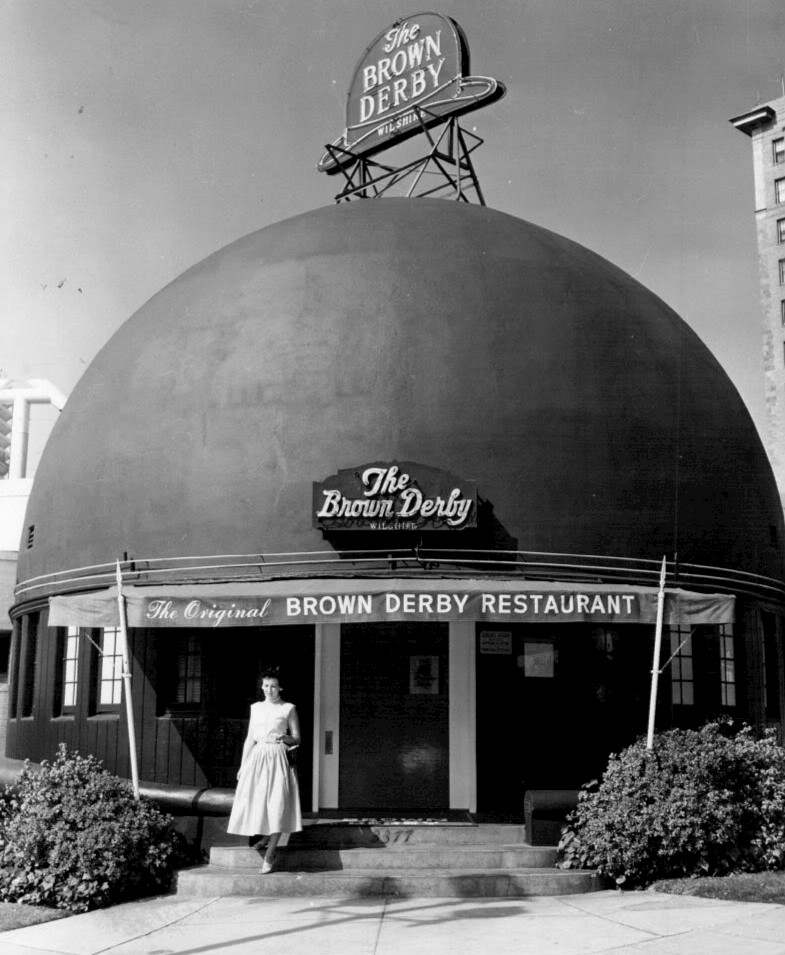
After Sept. 11, 2001, the same
dire predictions about New York’s restaurant
industry never recovering proved to be extremely
short-sighted. At the time New York had about
20,000 restaurants; today the city is home to
26,000.
When Hurricane Katrina in 2005
destroyed New Orleans’s restaurant sector, sending
employees flowing out of town, it was predicted
they would never return to a city so damaged and
without any tourism. Yet the lights were back on
within weeks in the city. Indeed, in the aftermath
of Katrina New Orleans gained restaurants. Where
there had been 984 restaurants in the city before
the hurricane, there are now more than 1,300, an
increase of about 30%.
Because of this history of
resilience I am convinced that America’s
restaurant industry will not just survive but
thrive, and, once the All Clear signal is sounded,
it will happen rapidly. To be sure, no one knows
what seismic changes may occur, how fine dining
versus storefront eateries will be affected, how
much more take-out and delivery will be
available. But, unlike the devastation of
wars and hurricanes, in America food service
spaces are still intact, and real estate, like Nature, abhors
a vacuum.
Certainly many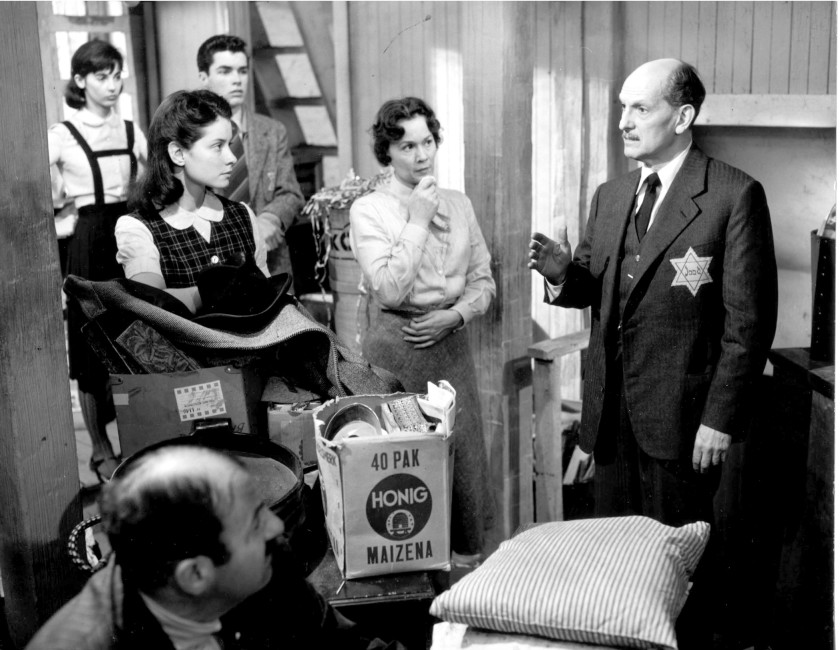 operators
will never re-open their restaurants, but others
will take their place, modify their expectations
and be more responsive to the public’s wants and
needs. More
than with most leisure time endeavors, people want
desperately to eat out again, and restaurants will
respond to that enormous appetite.
operators
will never re-open their restaurants, but others
will take their place, modify their expectations
and be more responsive to the public’s wants and
needs. More
than with most leisure time endeavors, people want
desperately to eat out again, and restaurants will
respond to that enormous appetite.
I am reminded of a scene in The Diary of
Anne Frank (left), in which the family
members, isolated for months in an attic, but
still believing they would soon be out, fantasize
about the first thing they’ll do when they return
to the world outside. Anne says she yearns
to go to a dance. Her teenage brother wants to go
to a movie, a western movie! And the adults all
start remembering and dreaming of a wonderful
pastry shop, a good stew, a romantic restaurant
with thick linen and fine wines.
So, when
we all finally emerge from our homes, we’ll all
want to go to a restaurant for a good stew and
fine wine, for it is the surest sign that all is
well again. And the people who run our restaurants
will respond as they always have, because they
would love nothing more than to feed us all.
❖❖❖
PASSES AWAY AT 89
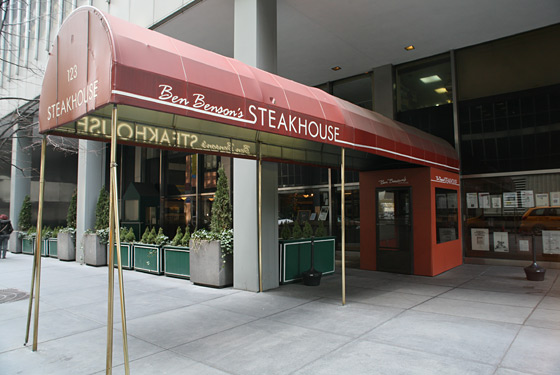 Ben
Benson,
one of New York’s exemplars in the highly
competitive steakhouse genre, has died at the age
of 89. Ever familiar in his brightly colored
sweaters, Ben would walk slowly through
Ben
Benson,
one of New York’s exemplars in the highly
competitive steakhouse genre, has died at the age
of 89. Ever familiar in his brightly colored
sweaters, Ben would walk slowly through  his two-story restaurant on West 52nd
Street, seemingly aloof. The
truth was, Ben had been legally blind since
college and once said, “People think I’m a snob.
It’s difficult because I can’t make eye contact.”
his two-story restaurant on West 52nd
Street, seemingly aloof. The
truth was, Ben had been legally blind since
college and once said, “People think I’m a snob.
It’s difficult because I can’t make eye contact.”
But if he could not connect by eye with his
legion of regulars, he kept his professional eye
on every aspect of hospitality and quality at his
restaurant, which was decked out with folk art,
antlers and brass. No one bought better beef or
lamb chops. His creamed spinach was nonpareil, and
fried items like onion rings were irresistible
once tasted. The wine list had depth and breadth
and high prices, and his service staff, many
long-time veterans from Eastern Europe, could
carve open a
roast chicken or shell a lobster with equal parts
speed and grace.
With
Alan Stillman, a fellow Bucknell alumnus, Ben founded the
TGIFriday restaurants, and opened Smith &
Wollensky with him on the East Side, which itself
grew into a franchise chain. But Ben refused to
open more than one steakhouse with his own name on
it, telling the Times, "There
will never, never, never be another Ben Benson's."
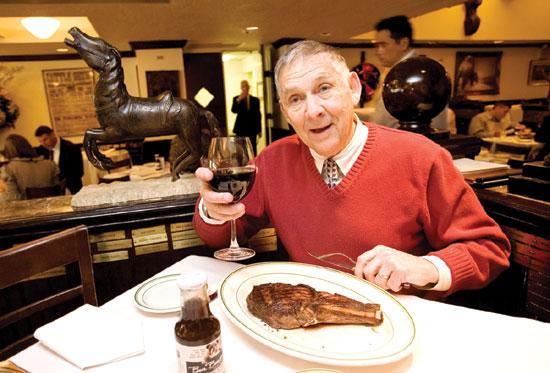 Ben Benson’s Steakhouse
opened in 1982 and had a terrific run, but after
the downturn in 2008, business slumped and never
returned to acceptable heights. In addition, more
than a dozen new highly competitive steakhouses
had opened on the West Side. That, plus an
enormous rent hike, forced him finally to close
the restaurant on Father’s Day in 2012, with vague
plans to re-open somewhere else. But Ben was
getting older and his sight wasn’t getting any
better.
Ben Benson’s Steakhouse
opened in 1982 and had a terrific run, but after
the downturn in 2008, business slumped and never
returned to acceptable heights. In addition, more
than a dozen new highly competitive steakhouses
had opened on the West Side. That, plus an
enormous rent hike, forced him finally to close
the restaurant on Father’s Day in 2012, with vague
plans to re-open somewhere else. But Ben was
getting older and his sight wasn’t getting any
better.
I
have to imagine that Ben was a tough negotiator
and taskmaster in his business, but I only knew
him as a very sweet, very New York kind of guy,
ready to hear or tell a good story, eager to
recommend a particular dish of the evening and
someone who clearly loved what he did. That’s the
way it is with true restaurateurs and why they
stay in business for thirty years. Everybody knew
Ben and everyone looked up to him. There
will never, never, never be another Ben Benson.
❖❖❖
By John Mariani
LOVE AND PIZZA
Since, for the time being, I am unable to write about or review New York City restaurants, I have decided instead to print a serialized version of my (unpublished) novel Love and Pizza, which takes place in New York and Italy and involves a young, beautiful Bronx woman named Nicola Santini from an Italian family impassioned about food. As the story goes on, Nicola, who is a student at Columbia University, struggles to maintain her roots while seeing a future that could lead her far from them—a future that involves a career and a love affair that would change her life forever. So, while New York’s restaurants remain closed, I will run a chapter of the Love and Pizza each week until the crisis is over. Afterwards I shall be offering the entire book digitally. I hope you like the idea and even more that you will love Nicola, her family and her friends. I’d love to know what you think. Contact me at loveandpizza123@gmail.com
—John Mariani
Cover Art By Galina Dargery
CHAPTER SIX
By the fall of her junior
year, Nicola was regarded as one of the most
promising students in her major, and her
professors, including Rhys St. John, were only
too happy to write letters of recommendation
for graduate school, including Columbia,
though she was thinking that a change of
scenery would not be a bad thing for her.
After all, she was now twenty and, except for
a couple of family trips to relatives’ houses
in Florida and New England, she really hadn’t
been anywhere outside of New York.
 Still,
Nicola loved New York and thought she had barely
scratched the surface of the city’s cultural
life. She
would get free or discount student tickets,
tacked to bulletin boards, to Off- Broadway
shows, student admission to art galleries and
museums, and could sit in on just about any
class at any other college in the area. Then
there were concerts in the parks, even up in the
Bronx’s Pelham Bay Park, and there were street
fairs almost every weekend in spring and fall.
Still,
Nicola loved New York and thought she had barely
scratched the surface of the city’s cultural
life. She
would get free or discount student tickets,
tacked to bulletin boards, to Off- Broadway
shows, student admission to art galleries and
museums, and could sit in on just about any
class at any other college in the area. Then
there were concerts in the parks, even up in the
Bronx’s Pelham Bay Park, and there were street
fairs almost every weekend in spring and fall.
She sometimes thought she
could spend her entire life just returning every
weekend to the Metropolitan Museum of Art (left) on
Fifth Avenue, just to idly roam the vast
hallways and galleries, especially the
Renaissance collection. She’d crane her neck
till it hurt looking at the Tiepolos high on the
walls. She
felt calmed by Bellini’s “Madonna and Child,”
beguiled by Lorenzo Lotto’s “Venus and Cupid”
and the Neapolitan artist Gaspare Traversi’s
“Teasing a Sleeping Girl” always made her laugh.
But she was enraptured by the astonishing
sensual realism and the dramatic play of light
and darkness in Caravaggio’s “The Musicians” (below).
The Met was always fitted out
with new exhibits that took years to mount.
Indeed, Nicola often thought that, instead of
teaching, museum curating might be where her
life and career were headed after grad school,
maybe to work in research, acquisition, perhaps
even restoration at the Met, who knows?
Nicola
knew well that those were not always high-paying
jobs, even at the Met, where many of the staff
were rich New York society women who never
really had to work at all but enjoyed the
prestige, and, yes, the applause for doing
something in the arts that demanded true
scholarship.
She’d met plenty like them at Columbia,
women with three names, like Dylan Leuwellen
Willinger or Lara Langseth Warner, their fathers
the head of a New York bank or a real estate
developer on the West Side. Some
were very bright and did good work, but there
was little doubt that they were largely legacy
students whose families had donated heavily to
the school.
Some of them even had their family names
attached to the newer campus buildings or wings.
The Met would be a stretch,
but she might work her way up to it, perhaps
beginning in Europe—where the salaries were even
lower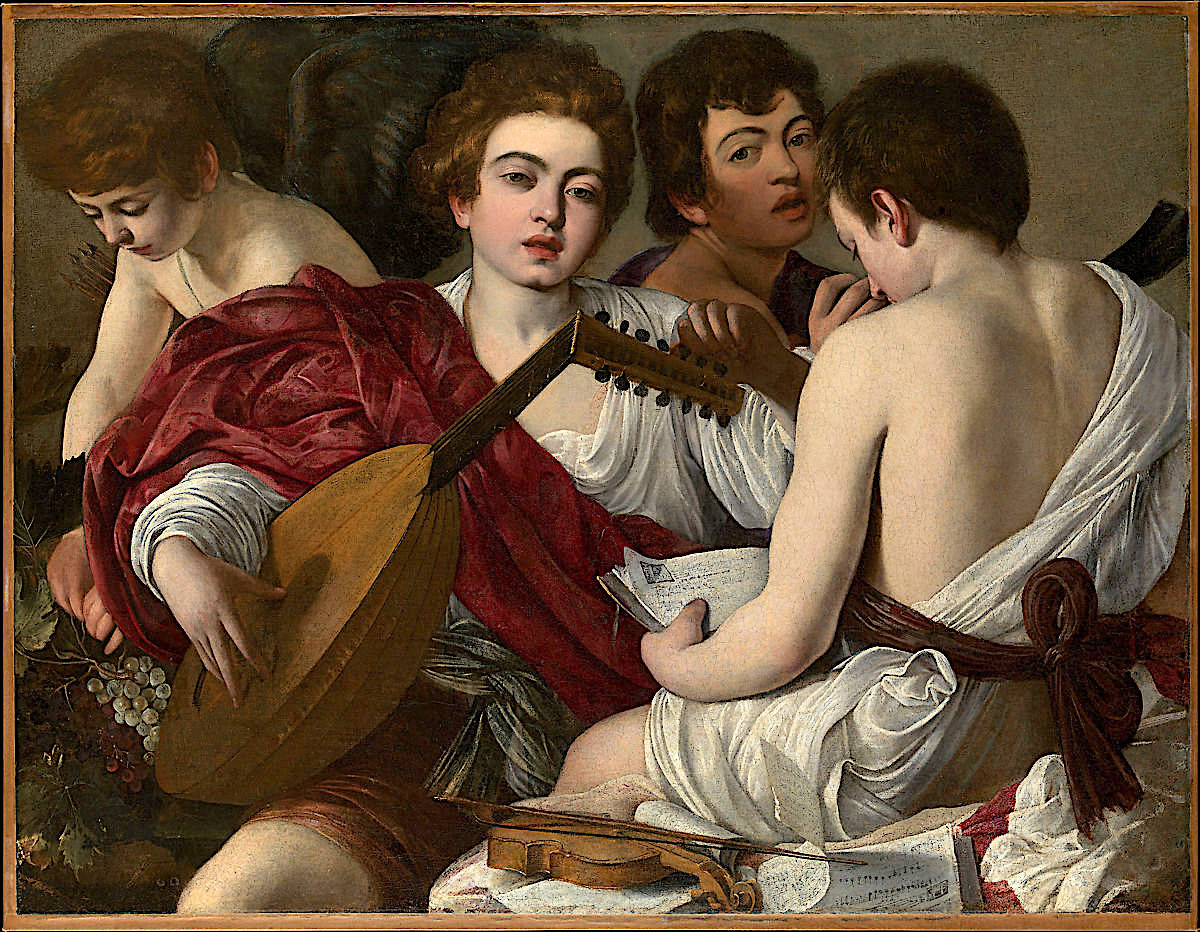 and jobs for
non-European scholars almost impossible to come
by, unless you were a teacher at one of the many
schools that offered semesters abroad or
exchange student programs.
and jobs for
non-European scholars almost impossible to come
by, unless you were a teacher at one of the many
schools that offered semesters abroad or
exchange student programs.
And that was why Nicola had
applied to spend the spring 1985 semester of her
junior year abroad, in Italy if possible, where
Columbia had several very fine programs, one in
Rome, one in Florence—those two were almost
always filled up quickly—and one in Milan. So in
order to guarantee her getting into a program,
Nicola chose Milan, whose art treasures she knew
would easily keep her busy for well more than a
semester.
The added virtue of the program was that
her Columbia tuition would be used to cover the
Milan program, although she would have to pay
for her lodgings abroad.
One cold, sleeting afternoon
during the Christmas break, Nicola came home to
find an envelope with the Columbia logo on it,
propped up against a vase of begonias in the
Santini dining room. Her mother, father, sister
Natalie and brother Tommy stood there smiling.
“Is that the letter you’ve
been waiting for, Nick?” asked Natalie.
“I, er, guess
it is,” said Nicola.
“So, open it,” said her
father. “You wanna kill us with suspense?”
Nicola picked up the
envelope, ripped off the edge, blew into it and
took out the letter. She read the first
paragraph at a glance and exclaimed, “I’m going
to Milan! I’m really going to Milan!”
Her mother clasped her hands
and said, “Oh, thank, God! I said a novena for
you and now it’s come true!”
The rest of the family danced
about the room and congratulated their scholar
sister, hugging her again and again, Tommy
lifting her off the ground and crushing the
breath out her.
Nicola’s acceptance into the program was
really not much of a surprise, it was a foregone
conclusion, but the very idea of her being the
first Santini child to go to Italy to study was
cause for celebration.
Anthony
said, “Natalie, call your sister and brother.
Tommy, go pick up your grandmother and bring her
over. I’m
going around the corner to buy lobsters and get
a special bottle of wine. Maybe two or three. Maybe
Champagne! Who knows! My baby’s going to Italy!”
Then, cuddling Nicola’s chin,
he said, “You know, Nicky, we are so proud of
you, but you know who’s going to be the most
proud?”
“I know, Papa. Grandma. She’s
a lot of the reason I got this letter.”
Nicola’s sister Roseanne and
brother-in-law would come over that evening, and
as soon as Tony could leave the restaurant, he
would be there too. When Teresa arrived,
bundled in a beautiful heather wool coat she’d
had for thirty years, she said nothing at first,
removed her coat, looked at Nicola and said, “Vieni,
carissima.” The
two of them embraced and broke into tears of
joy, each taking turns wiping the other’s cheeks
with Teresa’s linen handkerchief.
“This is what I dreamed of
for you since the day you were born, Nicola,”
said Teresa. “You going to Italy, you see all
the things I told you about. All
the things I always want to see.”
“But you can still see them,
Grandma, you can come visit.”
Teresa shook her head a
little, wiped the last tears from Nicola’s red
cheeks, and said, “Maybe. Maybe not. God knows
it had better be soon. I can't travel so much no
more.”
Nicola’s lower lip stiffened
again and she held back more tears.
“Okay, then, Grandma, you
come soon, while I’m there, and maybe I can show
you
some beautiful things for once.”
“Io spero.
I hope so, cara.”
Tony arrived carrying two
boxed pizzas from Bella Napoli, which the family
enjoyed with a bottle of Moët Champagne. Anna
was in the kitchen making a quick marinara
spiked with chili peppers that would adorn the
lobsters. Anthony took care cooking the lobsters
in boiling water, then removed them and cracked
their shells before putting them together with
the spicy tomato sauce. When Roseanne and her
husband arrived, she went straight to the
kitchen to make the salad.
 Within
an hour, buoyed by the Champagne and pizza, the
extended Santini family was seated, said grace,
and, with Roseanne and Natalie holding the
platters, took portions of the steaming
shellfish and spaghetti, an Italian-American
dish called “lobster fra diavola,”
lobster with the devil, because of the red color
of the dish and the heat of the chilies. Dessert
was an array of Italian cookies and pastries
bought down the street at Egidio Pastry Shop (left).
Within
an hour, buoyed by the Champagne and pizza, the
extended Santini family was seated, said grace,
and, with Roseanne and Natalie holding the
platters, took portions of the steaming
shellfish and spaghetti, an Italian-American
dish called “lobster fra diavola,”
lobster with the devil, because of the red color
of the dish and the heat of the chilies. Dessert
was an array of Italian cookies and pastries
bought down the street at Egidio Pastry Shop (left).
As the evening wound down,
Nicola and her father sat on an old sofa away
from the others. He put his arm around her,
kissed her cheek, and started to croon, very
low, an Italian song he used to sing to her when
she was a child.
Nicola nestled into his arms and said, “I
haven't heard that in so many years, Papa. I
always loved it when you sang it to me.”
“Every night. Sometimes
twice! You always asked for that one.”
Nicola smiled, paused, then
said, “Papa, one thing: this coming semester in
Italy is going to cost a bit more for my room
and board than just the tuition. . .”
Anthony put his fingers on
her lips and said, “Sssh! Don’t even bring it
up. I’ve taken care of it. It’s
not that much money.”
“But—"
“I said, shoosh! It’s done.
Over. Don’t even think of it again. You think
I’m gonna let my beautiful Nicky go off to Italy
without room and board? Plus, food is so cheap
there. You
can get a plate of pasta for five bucks, an
espresso for fifty cents. You
just don't worry.
I know what kind of girl you are, Nicky. You’re
not gonna be spending money all over the place
for no good reason. But I expect you to have fun,
too. I been
to Rome and Venice and Florence but never been
to Milan. It’s got a northern attitude, but
it’s a great city. Rains a lot, but you’ll
love it.”
Then it was Anthony’s turn to
be quiet.
“Papa,” said Nicola.
“What?”
“I’m going to miss you so
much. I’ll miss everyone, Mom, Grandma,
everyone.
You know, I’m not as tough a Bronx girl
as you might think. It’s a little scary to go
off on my own to a foreign country for the first
time.”
“What
foreign country? Italy’s not a foreign country.
It’s your ancestral homeland, you speak some
Italian, you’re beautiful, everyone’s gonna love
you. It’s a big city, but you’ve spent your life
in a big city.
You’ll do fine, bella.”
“I know,” said Nicola. “But I
promise
you I’m going to be so homesick I’ll cry myself
to sleep every night.”
Anthony chuckled. “Hm, maybe
the first two or three nights. After
that you won't even think
about the old neighborhood. Jesus,
Nicky, I’m worried you may love it over there so
much, you may never come back.”
“Papa, I swear that
won’t happen.
For one thing I have to finish college
next year, then maybe grad school here—"
“Italy has, what do they say,
fatal charms?
Ah, I know you’ll be back. You’ll
miss Mom and Grandma’s cooking. I
don’t want you getting any skinnier. Now, let’s
stop talking and say goodnight to everyone.”
COMFORT WINES
By Geoff Kalish
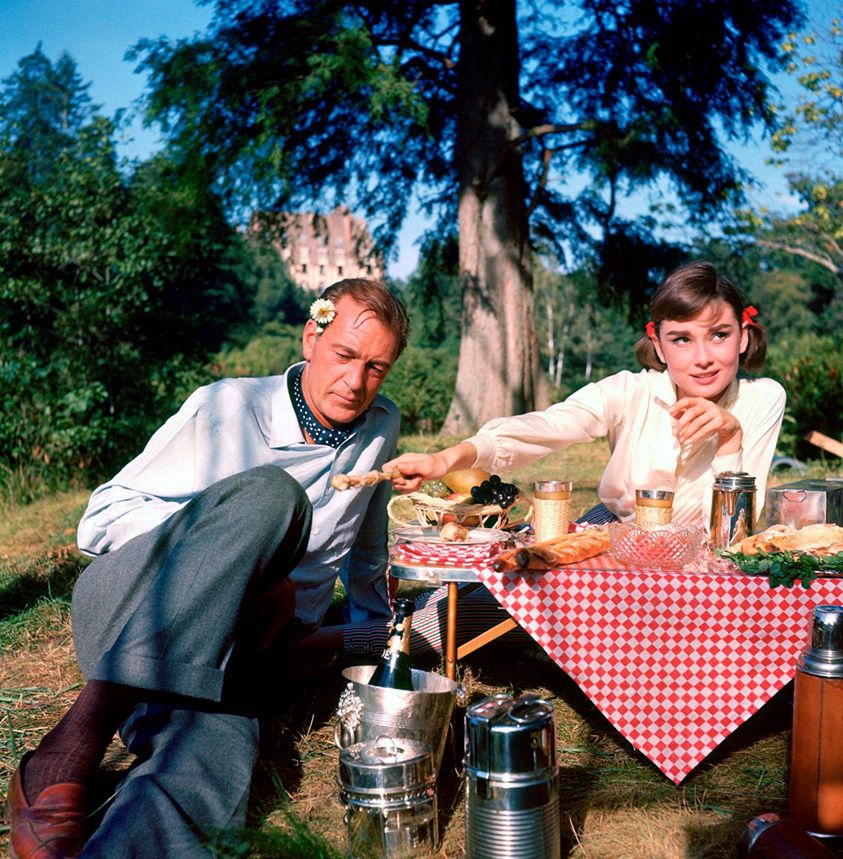
Gary Cooper and Audrey Hepburn in "Love in the Afternoon"
It’s well known that in times of
crisis people gravitate to that which brings
them easy comfort. And in the past few weeks,
during this coronavirus pandemic, what I’ve
found is that it’s the simple, easy-drinking
wines that bring the most comfort and enjoyment.
In fact, drinking very complex
wines that require pondering to enjoy fully, like
well-aged vintage Bordeaux and even young premier
cru Chablis, are much less comforting than
simpler, easy drinking whites, reds, and
sparklers, many
of which might cause connoisseurs to turn up their
noses. And yes, I realize that with the
stay-at-home restrictions in many areas, consumers
may be reaching for wine closet or wine cellar
stock more often than usual. But even in heavily
hit New York City, wine shops are open and
offering delivery and curb-side pick-up services.
So, based on my experience this
past month, the following are some of these widely
available “comfort wines” that should provide a
salve to the wounds of the crisis, so long as they
are consumed in moderation. (Of note, studies have
shown that too much alcohol can weaken the immune
system, something we should be very careful about
in general and especially in these times.) And,
I’ve provided a bit of background information on
each of the wines, not to ponder but to occupy
some of your time and allow a brief escape from
the current “mind-boggling” events of the world.
REDS
 2018
Bodegas Borsao Garnacha ($9)—In the 1950s
Spain’s struggling economy forced a number of
small wine producers to form cooperatives to
survive, of which Bordegas Bosao was one. Founded
in 1958 and starting as a small cooperative winery
in northwestern Spain, about three hours north of
Madrid, it now includes over 600 growers and
offers some of the best wine bargains available.
The wine is made from primarily Grenache blended
with smaller amounts of Tempranillo and Syrah. It
has a bouquet and taste of cherries and
raspberries and a smooth, easy drinking taste that
mates with most fare, especially beef and lamb and
even hamburgers and hot dogs.
2018
Bodegas Borsao Garnacha ($9)—In the 1950s
Spain’s struggling economy forced a number of
small wine producers to form cooperatives to
survive, of which Bordegas Bosao was one. Founded
in 1958 and starting as a small cooperative winery
in northwestern Spain, about three hours north of
Madrid, it now includes over 600 growers and
offers some of the best wine bargains available.
The wine is made from primarily Grenache blended
with smaller amounts of Tempranillo and Syrah. It
has a bouquet and taste of cherries and
raspberries and a smooth, easy drinking taste that
mates with most fare, especially beef and lamb and
even hamburgers and hot dogs.
2017 Castello di
Volpaia Chianti Classico ($22)—This
wine, made from certified organic grapes, hails
from a village built in the 10th century in the
Radda township in central Italy. It began
producing wine in the 19th century but in the late
1950s stopped because all the villagers fled to
the big cities during a period of severe economic
downturn as a result of the industrial revolution.
However, in 1966 a wealthy printer named Raffaelle
Stianti purchased the village as a gift for his
15-year-old daughter, who a few years later
married Carlo Maccheroni and decided to
“refurbish” the winery. Since the town was a
“designated” historic site, they could not alter
the walls, but brought in tanks and barrels by
removing and replacing the roofs of the buildings
as well as connecting the buildings by huge
underground pipes that could carry wine. Today,
the winery is run by their charming daughter,
Federica, and her husband. The wine shows a fruity
bouquet and taste of ripe plums and cherries and
has a smooth finish with a hint of spice that
mates well with chicken, salmon or pasta with red
sauce.
2018 Turley Juvenile
Zinfandel ($30)—After a stint as
part-owner of Frog’s Leap Winery, Tennessee native
and Emergency Room physician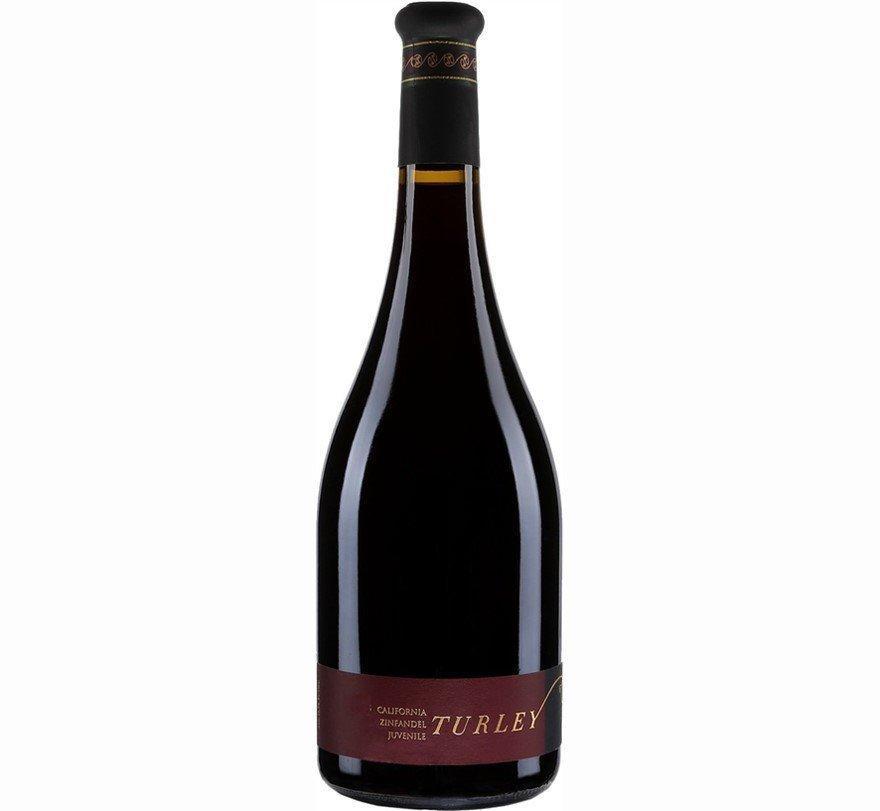 Larry Turley founded Turley Wine
Cellars in 1993 in Templeton, California, midway
between San Francisco and Los Angeles.
Specializing in Zinfandel, the winery now produces
47 separate wines from more than 50 vineyards. And
while most are single vineyard bottlings, the
Juvenile (as its
Larry Turley founded Turley Wine
Cellars in 1993 in Templeton, California, midway
between San Francisco and Los Angeles.
Specializing in Zinfandel, the winery now produces
47 separate wines from more than 50 vineyards. And
while most are single vineyard bottlings, the
Juvenile (as its  name suggests) is made
from a blend of Zinfandel grapes harvested from
younger vines growing on a dozen and a half
separate vineyards (most of which are certified
organic) and fermented with indigenous yeasts. It
shows a fragrant bouquet and jammy taste of
raspberries and strawberries with a touch of
cranberry and notes of vanilla in its finish. It
marries well with grilled lamb, barbecued chicken
and ribs or dark veined cheeses.
name suggests) is made
from a blend of Zinfandel grapes harvested from
younger vines growing on a dozen and a half
separate vineyards (most of which are certified
organic) and fermented with indigenous yeasts. It
shows a fragrant bouquet and jammy taste of
raspberries and strawberries with a touch of
cranberry and notes of vanilla in its finish. It
marries well with grilled lamb, barbecued chicken
and ribs or dark veined cheeses.
2016 Tenute Luce-Lucente ($27)—This wine hails from a Tuscan winery in Montalcino, 20 miles south of Siena, founded in 1995 as a joint venture between Robert Mondavi and Vittorio Frescobaldi—the first American-Italian wine collaboration in Italy. This is actually the “second” label wine made at the winery The first, Luce della Vita—meaning the “light on the vine” seen on the ride from Florence to Montalcino—is many times more expensive and perennially one of the highest rated wines from Italy. However, the Lucente is no slouch, and much easier drinking in its youth than the Luce. It has a bouquet and taste of ripe plums and cherries with notes of chocolate and hints of sage in its long finish. It’s perfect to accompany pasta or risotto primavera, braised beef, duck breast as well as swordfish or tuna.
WHITES
2017 Ravines Dry
Riesling ($17)—This wine hails from a
winery foundered on the east side of Keuka Lake in
New York’s Finger Lake  Region in 2001 by
winemaker Morten Hallgren, whose prior experience
was at Cos d’Estournel and Konstantin Frank
Cellars, and his wife, Lisa. The winery takes its
name from the ravines in the area that draw water
and cool air from the vineyards. While the winery
did not have an auspicious beginning as one of the
first, if not the first, to make a dry Riesling,
which was not popular with locals and visitors,
Lisa brought bottles to New York City, where the
wine achieved quick popularity and critical
acclaim. In fact, the wine has been named to the
top 100 wines for the past eight years by Wine
Spectator. Because of its success, new
vineyards were purchased and the main facility
moved to larger space in Geneva, on Seneca Lake.
The wine shows a distinct, floral bouquet and
taste of green apples and peaches with notes of
lime in its dry, vibrant finish. In addition to
mating well with grilled or broiled trout or
soft-shell crabs, it goes remarkably well with egg
dishes, like omelets or huevos rancheros.
Region in 2001 by
winemaker Morten Hallgren, whose prior experience
was at Cos d’Estournel and Konstantin Frank
Cellars, and his wife, Lisa. The winery takes its
name from the ravines in the area that draw water
and cool air from the vineyards. While the winery
did not have an auspicious beginning as one of the
first, if not the first, to make a dry Riesling,
which was not popular with locals and visitors,
Lisa brought bottles to New York City, where the
wine achieved quick popularity and critical
acclaim. In fact, the wine has been named to the
top 100 wines for the past eight years by Wine
Spectator. Because of its success, new
vineyards were purchased and the main facility
moved to larger space in Geneva, on Seneca Lake.
The wine shows a distinct, floral bouquet and
taste of green apples and peaches with notes of
lime in its dry, vibrant finish. In addition to
mating well with grilled or broiled trout or
soft-shell crabs, it goes remarkably well with egg
dishes, like omelets or huevos rancheros.
2018 Domaine Fevre
Chablis ($32)—While this winery, founded
in 1959 and headquartered in the town of Chablis,
makes spectacular premier cru Chablis, especially
from the Vaulorent vineyard, those wines require a
few years of bottle aging to reach their full
potential. Not so with this wine, also from grapes
grown in “Kimmeridgian” soil, which contains
fossilized oyster shells as well as clay and
limestone. In its youth it shows a bouquet and
rich taste of 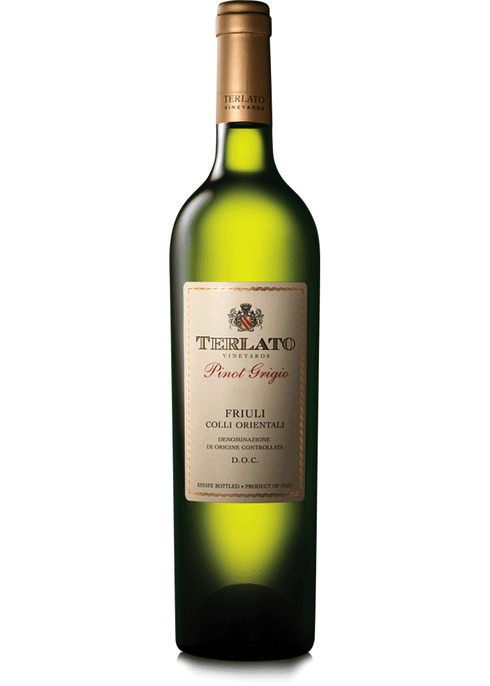 melons and pears with strong notes
of citrus in its vibrant finish and mates well
with shrimp, scallops, oysters on the half shell
or even roast turkey.
melons and pears with strong notes
of citrus in its vibrant finish and mates well
with shrimp, scallops, oysters on the half shell
or even roast turkey.
2018 Terlato Family
Friuli Pinot Grigio (2018)—Anthony
Terlato, known as “The Father of Pinot Grigio” for
introducing Santa Margherita Pinot Grigio into the
U.S. market, started his wine career in his
father’s retail wine and spirits shop in 1955 and
then at his father-in-law’s company that imported
the wines of industry legends Alexis Lichine and
Frank Schoonmaker. Since that time he has had a
storied career involving importation of major
European brands as well as owning wineries in
California and Italy along with his sons Bill and
John. This
wine, made from hand-harvested grapes grown in
northeastern Italy, was fermented in a combination
of stainless-steel and barrels, then underwent a
year of barrel aging on its lees and then another
year of bottle aging. It has a bouquet and taste
of pears and melons with distinct notes of almonds
in its refreshing finish. 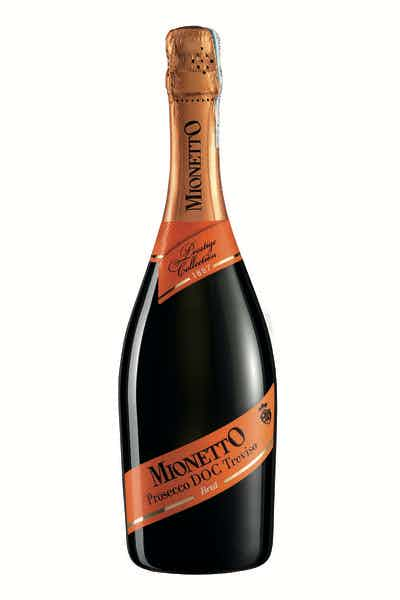 Mate it with cod, sushi or even
smoked salmon, as well as aged cheeses.
Mate it with cod, sushi or even
smoked salmon, as well as aged cheeses.
SPARKLING
Mionetto Prosecco DOC
Treviso Brut ($12)—This bubbly is from a
winery located in the Valdobbiadene region,
between Verona and Venice, founded in 1887 by
Francesco Mionetto. It’s made from 100% Glera
grapes fermented to a still wine then allowed to
go through a second fermentation by the Charmat
Method, which involves placing the wine in large
stainless-steel vats with yeast. While not as
elegant as Champagne, this wine has an apple and
spice bouquet and taste and a vibrant finish not
dissimilar to a number of much more pricey
prestige bottles from France. It pairs well with
appetizers like bruschetta or melon wrapped in
prosciutto as
well as with main course items like lobster or
Cornish game hens.
Sponsored By

Any of John Mariani's books below may be ordered from amazon.com.
 The Hound in Heaven
(21st Century Lion Books) is a novella, and
for anyone who loves dogs, Christmas, romance,
inspiration, even the supernatural, I hope you'll find
this to be a treasured favorite. The story
concerns how, after a New England teacher, his wife and
their two daughters adopt a stray puppy found in their
barn in northern Maine, their lives seem full of promise.
But when tragedy strikes, their wonderful dog Lazarus and
the spirit of Christmas are the only things that may bring
his master back from the edge of despair.
The Hound in Heaven
(21st Century Lion Books) is a novella, and
for anyone who loves dogs, Christmas, romance,
inspiration, even the supernatural, I hope you'll find
this to be a treasured favorite. The story
concerns how, after a New England teacher, his wife and
their two daughters adopt a stray puppy found in their
barn in northern Maine, their lives seem full of promise.
But when tragedy strikes, their wonderful dog Lazarus and
the spirit of Christmas are the only things that may bring
his master back from the edge of despair. WATCH THE VIDEO!
“What a huge surprise turn this story took! I was completely stunned! I truly enjoyed this book and its message.” – Actress Ali MacGraw
“He had me at Page One. The amount of heart, human insight, soul searching, and deft literary strength that John Mariani pours into this airtight novella is vertigo-inducing. Perhaps ‘wow’ would be the best comment.” – James Dalessandro, author of Bohemian Heart and 1906.
“John Mariani’s Hound in Heaven starts with a well-painted portrayal of an American family, along with the requisite dog. A surprise event flips the action of the novel and captures us for a voyage leading to a hopeful and heart-warming message. A page turning, one sitting read, it’s the perfect antidote for the winter and promotion of holiday celebration.” – Ann Pearlman, author of The Christmas Cookie Club and A Gift for my Sister.
“John Mariani’s concise, achingly beautiful novella pulls a literary rabbit out of a hat – a mash-up of the cosmic and the intimate, the tragic and the heart-warming – a Christmas tale for all ages, and all faiths. Read it to your children, read it to yourself… but read it. Early and often. Highly recommended.” – Jay Bonansinga, New York Times bestselling author of Pinkerton’s War, The Sinking of The Eastland, and The Walking Dead: The Road To Woodbury.
“Amazing things happen when you open your heart to an animal. The Hound in Heaven delivers a powerful story of healing that is forged in the spiritual relationship between a man and his best friend. The book brings a message of hope that can enrich our images of family, love, and loss.” – Dr. Barbara Royal, author of The Royal Treatment.
 |
The Encyclopedia of American Food and Drink by John F. Mariani (Bloomsbury USA, $35) Modesty forbids me to praise my own new book, but let me proudly say that it is an extensive revision of the 4th edition that appeared more than a decade ago, before locavores, molecular cuisine, modernist cuisine, the Food Network and so much more, now included. Word origins have been completely updated, as have per capita consumption and production stats. Most important, for the first time since publication in the 1980s, the book includes more than 100 biographies of Americans who have changed the way we cook, eat and drink -- from Fannie Farmer and Julia Child to Robert Mondavi and Thomas Keller. "This book is amazing! It has entries for everything from `abalone' to `zwieback,' plus more than 500 recipes for classic American dishes and drinks."--Devra First, The Boston Globe. "Much needed in any kitchen library."--Bon Appetit. |
"Eating Italian will never be the same after reading John Mariani's entertaining and savory gastronomical history of the cuisine of Italy and how it won over appetites worldwide. . . . This book is such a tasteful narrative that it will literally make you hungry for Italian food and arouse your appetite for gastronomical history."--Don Oldenburg, USA Today. "Italian
restaurants--some good, some glitzy--far
outnumber their French rivals. Many of
these establishments are zestfully described
in How Italian Food Conquered the World, an
entertaining and fact-filled chronicle by
food-and-wine correspondent John F.
Mariani."--Aram Bakshian Jr., Wall Street
Journal.
"Equal parts
history, sociology, gastronomy, and just
plain fun, How Italian Food Conquered the
World tells the captivating and delicious
story of the (let's face it) everybody's
favorite cuisine with clarity, verve and
more than one surprise."--Colman Andrews,
editorial director of The Daily
Meal.com. "A fantastic and fascinating
read, covering everything from the influence
of Venice's spice trade to the impact of
Italian immigrants in America and the
evolution of alta cucina. This book will
serve as a terrific resource to anyone
interested in the real story of Italian
food."--Mary Ann Esposito, host of PBS-TV's
Ciao
Italia. "John Mariani has written the
definitive history of how Italians won their
way into our hearts, minds, and
stomachs. It's a story of pleasure over
pomp and taste over technique."--Danny Meyer,
owner of NYC restaurants Union Square
Cafe, The Modern, and Maialino.
|
 |
 |
 |
 |
 |
 |
 |
 |
 Everett Potter's Travel Report:
Everett Potter's Travel Report: 
 Eating Las Vegas
JOHN CURTAS has been covering the Las Vegas
food and restaurant scene since 1995. He is
the co-author of EATING LAS VEGAS – The 50
Essential Restaurants (as well as
the author of the Eating Las Vegas web site: www.eatinglasvegas.
He can also be seen every Friday morning as
the “resident foodie” for Wake Up With the
Wagners on KSNV TV (NBC) Channel 3 in
Las Vegas.
Eating Las Vegas
JOHN CURTAS has been covering the Las Vegas
food and restaurant scene since 1995. He is
the co-author of EATING LAS VEGAS – The 50
Essential Restaurants (as well as
the author of the Eating Las Vegas web site: www.eatinglasvegas.
He can also be seen every Friday morning as
the “resident foodie” for Wake Up With the
Wagners on KSNV TV (NBC) Channel 3 in
Las Vegas.
MARIANI'S VIRTUAL GOURMET
NEWSLETTER is published weekly. Publisher: John Mariani. Editor: Walter Bagley. Contributing Writers: Christopher Mariani,
Robert Mariani, Misha Mariani, John A. Curtas, Gerry Dawes, Geoff Kalish,
and Brian Freedman. Contributing
Photographer: Galina Dargery. Technical
Advisor: Gerry
McLoughlin.
If you wish to subscribe to this
newsletter, please click here: http://www.johnmariani.com/subscribe/index.html
© copyright John Mariani 2020
